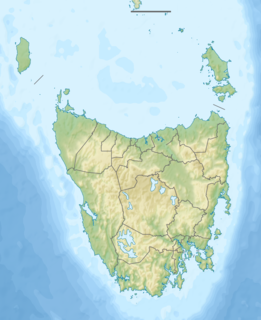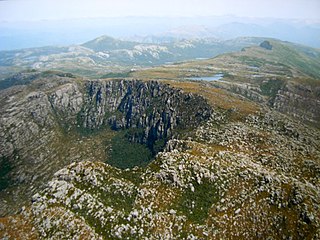| Mount Field West | |
|---|---|
 Mount Field West is the peak on the far left | |
| Highest point | |
| Elevation | 1,434 m (4,705 ft) AHD [1] |
| Prominence | 981 m (3,219 ft) [1] |
| Isolation | 68.92 km (42.82 mi) [1] |
| Coordinates | 42°39′19″S146°35′15″E / 42.65528°S 146.58750°E |
| Geography | |
Location in Tasmania | |
| Location | Tasmania, Australia |
Mount Field West is a mountain in the western portion of Mount Field National Park in the southern region of Tasmania, Australia.

A mountain is a large landform that rises above the surrounding land in a limited area, usually in the form of a peak. A mountain is generally steeper than a hill. Mountains are formed through tectonic forces or volcanism. These forces can locally raise the surface of the earth. Mountains erode slowly through the action of rivers, weather conditions, and glaciers. A few mountains are isolated summits, but most occur in huge mountain ranges.

Mount Field National Park is a national park in Tasmania, Australia, 64 km northwest of Hobart. The landscape ranges from eucalyptus temperate rainforest to alpine moorland, rising to 1,434 metres (4,705 ft) at the summit of Mount Field West.

Tasmania is an island state of Australia. It is located 240 km (150 mi) to the south of the Australian mainland, separated by Bass Strait. The state encompasses the main island of Tasmania, the 26th-largest island in the world, and the surrounding 334 islands. The state has a population of around 533,308 as of March 2019. Just over forty percent of the population resides in the Greater Hobart precinct, which forms the metropolitan area of the state capital and largest city, Hobart.
Contents
The mountain is frequently snow-covered, sometimes even in summer. It is a major feature of the national park, and is a popular destination for bushwalkers. It overlooks Upper Florentine Valley and is a 7.5 hour return walk from Lake Dobson.

The Upper Florentine Valley, in the south of Tasmania, Australia, is an area recognised for its landscape and old growth forests. It is situated along the Gordon River Road near Maydena in the southwest of the island, roughly three hours drive from Hobart and comprises around 60 square kilometres (23 sq mi) of temperate rainforest. The Upper Florentine forms part of the Florentine catchment upstream (south) from Churchill Creek and lies just outside the World Heritage Area. Geographically it is an area of generally low relief valleys and flats. The area is a known habitat for threatened species of flora and fauna, including sallow wattle, myrtle elbow orchid, grey goshawk, and spotted-tail quoll.
Mount Field West rises to 1,434 metres (4,705 ft) above sea level, [1] making it within the forty highest peaks in Tasmania.
The Australian Height Datum is a vertical datum in Australia. According to Geoscience Australia, "In 1971 the mean sea level for 1966-1968 was assigned the value of 0.000m on the Australian Height Datum at thirty tide gauges around the coast of the Australian continent. The resulting datum surface, with minor modifications in two metropolitan areas, has been termed the Australian Height Datum (AHD) and was adopted by the National Mapping Council as the datum to which all vertical control for mapping is to be referred."










